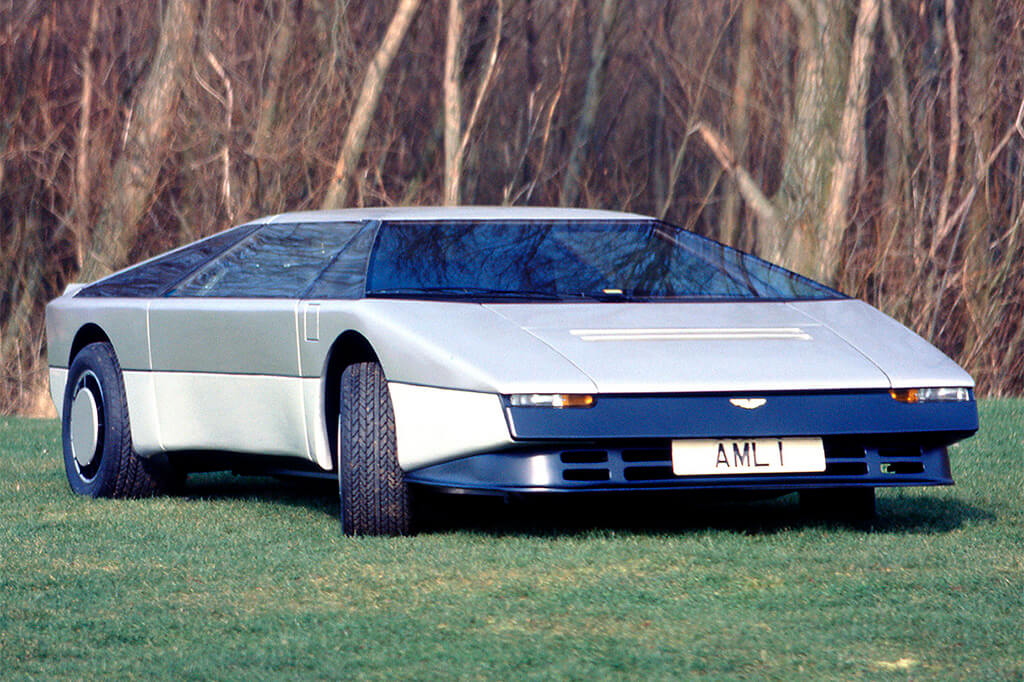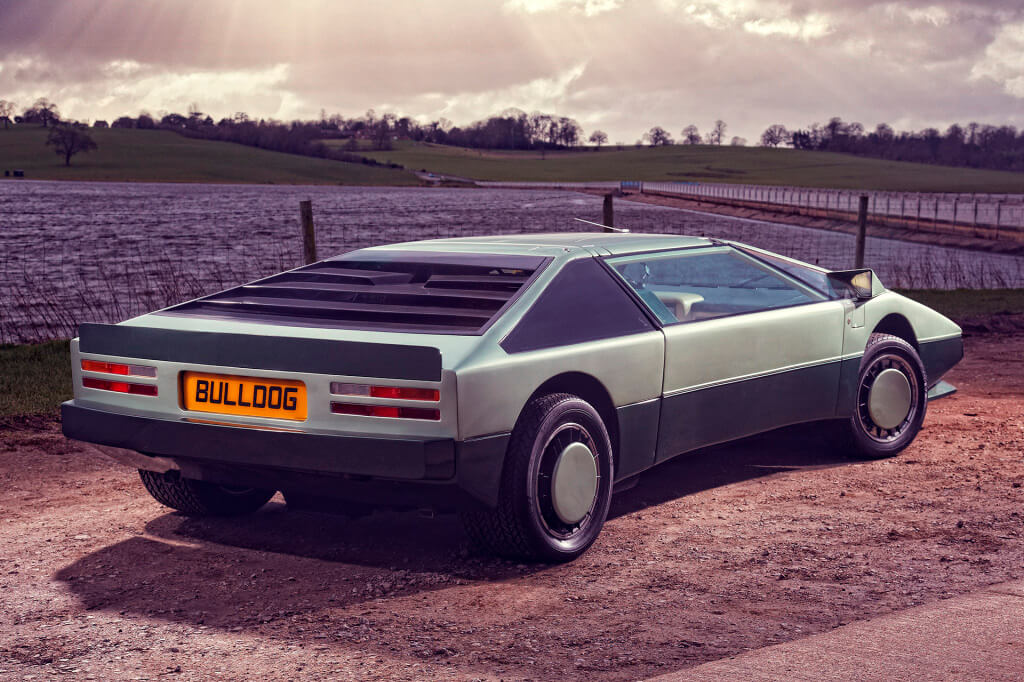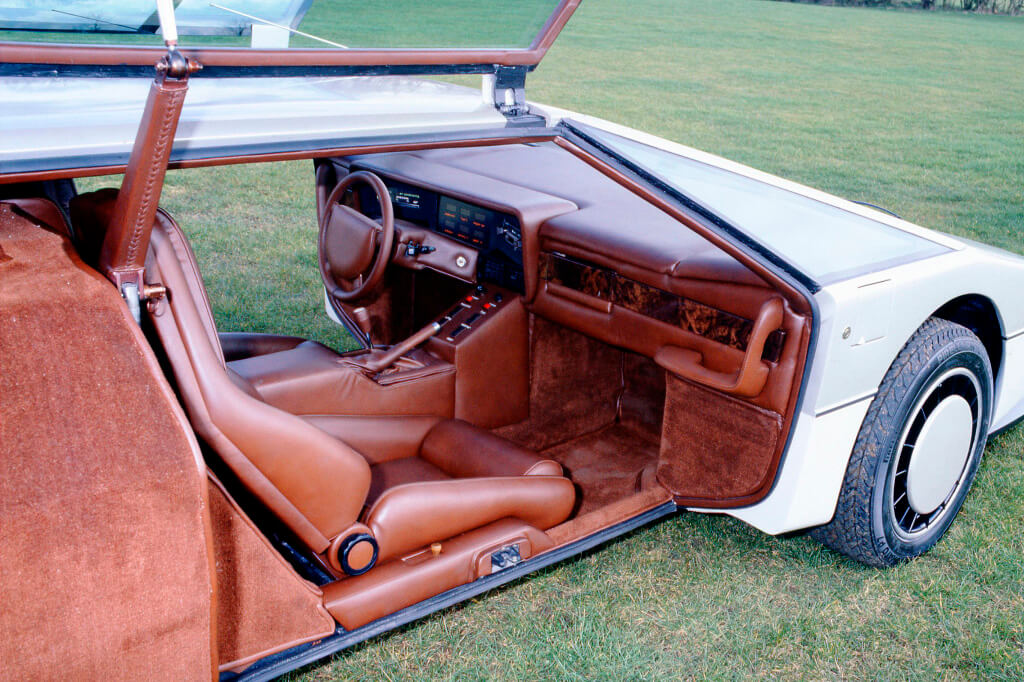Aston Martin Bulldog Concept
Description
Aston Martin Bulldog Concept is a prototype sports car. The code name for the project was DP K901. It was originally planned to produce 15-25 cars, but the project was considered too expensive and only one copy was built.
The car was officially unveiled on March 27, 1980 at the Bell Hotel in Aston Clinton. It was later shown at the 2009 Goodwood Festival of Speed and at the Aston Martin 100th Anniversary Celebration at Kensington Park Gardens in July 2013.
The body for the "Bulldog" was painted by a little-known designer Bill Towns, in the list of notable works of which, perhaps, only one item is the four-door Aston Martin Lagonda, which is also quite angular. However, the drag coefficient of the coupe was quite decent 0.34. The supercar was equipped with the now familiar gullwing doors (powered by the hood of the then V8 Volante) and some newfangled features from the same aerodynamics sphere - for example, small blades on rims. They were supposed to draw air into the wheels for more efficient cooling of the brakes. Later, a similar solution was used on the Porsche 956. And he also had five "hidden carry" headlights at once.
The project was strongly supported by the then managing director and co-owner of Aston Martin Lagonda, Alan Curtis. By the way, he also came up with the name of the supercar, naming it in honor of ... not a dog at all, but a small plane, which he then flew - Scottish Aviation Bulldog. In such an uncomplicated way, the future ultra-fast Aston became related to aviation. And on the sidelines of the research facility in Newport Pagnell, the project was rumored to be called K-9, after the robotic dog from the sci-fi series Doctor Who.
The official purpose of the development of the coupe was, as usual, to demonstrate that British engineers were by no means born with the same British bastard and were quite able to insert the pen to the Italians where they should, even on their favorite mid-engined field. It was this strategic goal that the potential ability of the Bulldog to accelerate to mind-blowing 230-240 miles per hour had to meet. In general, the supercar had to break the bar of 200 miles per hour, but the engineers were counting on more significant achievements.
The first prototype built was equipped with a 5.3-liter twin-turbocharged V8. According to some estimates, he developed up to 700 hp, although you can find references to 650, and even just 600 "horses". It was he who was sent for high-speed tests in order to see for himself the potential of the Bulldog. At the MIRA test site, the coupe managed to accelerate, if not to a record, but quite convincing 191 miles per hour (307 kph), and everything seemed to go according to plan. But not really.
Just at the turn of the decade, Aston Martin Lagonda's management changed: Victor Gauntlett, who bought out part of the company's shares, became the head of the company, who decided that Aston Martin could do without the Bulldog. According to Gauntlett, the project turned out to be too expensive, and the company simply could not afford it: the new leader did not want to pay for the ambitions of the engineers. Therefore, work on the supercar was stopped, the documentation, according to rumors, was partially destroyed, partially lost, and the only prototype available was simply sold to the side.
It is believed that it was bought by a certain collector from the Middle East, who paid an impressive 130 thousand pounds for the failed supercar, but he did not own it for long. For 35 years in private hands, "Bulldog" roamed the world a lot, visiting North America, and eventually returned to the UK - but noticeably changed. It has changed its steel-gray body color to an unintelligible green, and the interior is now trimmed in light colors, although it was previously a noble brown. The original 1980 photos by company photographer Roger Stowers are black and white, but they give some idea of the coupe's original appearance.
In 2020, the car was purchased by an American owner and a complete restoration project was started led by Victor Gauntlett's son Richard.
Unlike all previous Aston Martin models, the Bulldog is designed as a mid-engined car and rests on a central tubular frame. The front suspension consists of double wishbones with coil springs and an anti-roll bar, and a De-Dion axle with coil springs, trailing arms and a Watt linkage was installed at the rear. Compomotive split-rim alloy wheels used Pirelli P7 tires at the front in 225/50 R15 and at the rear in 345/35 R15.
The interior used a digital instrument panel, instead of a rear-view mirror, a screen connected to the rear camera was installed in the center console.
Sources
Specification
| Bodywork | |
|---|---|
| Years of production |
1980
|
| Produced (pcs.) |
1
|
| Body type |
купе
|
| Number of doors |
2
|
| Number of places |
2
|
| Engine | |
|---|---|
| Engine type |
бензиновый
|
| Engine location |
спереди, продольное
|
| Engine model |
Aston Martin
|
| Cylinders |
V8
|
| Capacity (cc) |
5341
|
| Power output (hp / kW /) |
585 /
430 /
|
| at rpm |
6200
|
| Torque (N·m) |
678
|
| at rpm |
5500
|
| Bore (mm) |
100,0
|
| Stroke (mm) |
85,0
|
| Compression |
7,5
|
| Number of valves |
2/16
|
| Valvetrain |
DOHC
|
| Block material |
алюминиевый сплав
|
| Fuel system |
впрыск
|
| Fuel system model |
Bosch
|
| Turbocharger |
2
|
| Compressor model |
Garrett AiResearch
|
| Transmission | |
|---|---|
| Driven wheels |
задний
|
| Gearbox model |
ZF
|
| Gearbox |
механическая
|
| Number of speeds |
5
|
| Final drive ratio |
3,200
|
| First gear ratio |
2,900
|
| Second gear ratio |
1,780
|
| Third gear ratio |
1,220
|
| Fourth gear ratio |
1,000
|
| Fifth gear ratio |
0,845
|
| Reverse gear ratio |
3,630
|
| Suspension | |
|---|---|
| Front suspension |
независимая
|
| Rear suspension |
независимая
|
| Elastic elements in front |
пружины
|
| Elastic elements in rear |
пружины
|
| Front anti-roll bar | |
| Rear anti-roll bar | |
| Wheels brand |
Compomotive
|
| Wheel size front |
8,5J×15
|
| Wheel size rear |
11J×15
|
| Tire brand |
Pirelli P7
|
| Tyres front |
225/50 R15
|
| Tyres rear |
345/35 R15
|
| Steering | |
|---|---|
| Steering type |
шестерня-рейка
|
| Turning diameter (m) |
12,2
|
| Brakes specs | |
|---|---|
| Brakes front |
дисковые вентилируемые
|
| Brakes rear |
дисковые вентилируемые
|
| Front brake diameter (mm) |
296
|
| Rear brake diameter (mm) |
296
|
| Disc material |
чугун
|
| Dimensions and weight | |
|---|---|
| Body |
стальной трубчатый каркас
|
| Length (mm) |
4724
|
| Width (mm) |
1917
|
| Height (mm) |
1092
|
| Wheelbase (mm) |
2769
|
| Front track (mm) |
1562
|
| Rear track (mm) |
1587
|
| Ground clearance (mm) |
90
|
| Drag coefficien |
0,340
|
| Dry weight (kg) |
1454
|
| Curb weight (kg) |
1723
|
| Weight distribution (%) |
40/60
|
| Performance specs | |
|---|---|
| Fuel consumption (EC) highway (l/100 km) |
13,4
|
| Fuel consumption (EC) city (l/100 km) |
21,3
|
| Fuel consumption (EC) combined (l/100 km) |
17,4
|
| Fuel consumption (EPA) highway (l/100 km) |
15,1
|
| Fuel consumption (EPA) city (l/100 km) |
27,4
|
| Fuel tank capacity (l) |
113
|
| Fuel type |
Аи-92
|
| Dynamic specs | |
|---|---|
| Acceleration 0-80 kph (s) |
4,2
|
| Acceleration 0-100 kph (s) |
5,1
|
| Acceleration 0-200 kph (s) |
12,2
|
| Acceleration 0-300 kph (s) |
45,2
|
| Acceleration 0-60 mph (s) |
5,1
|
|---|
| Acceleration 0-402 m (1/4 mile) (s) /kph/ |
11,9 /
|
|---|---|
| Acceleration 0-1000 m (s) /kph/ |
21,2 /
|
| Top speed (kph) |
307
|
|---|---|
| Top speed (mph) |
191
|
| Tags: | |
|---|---|
| Type: | |
| Brand: | |
| Country: |



